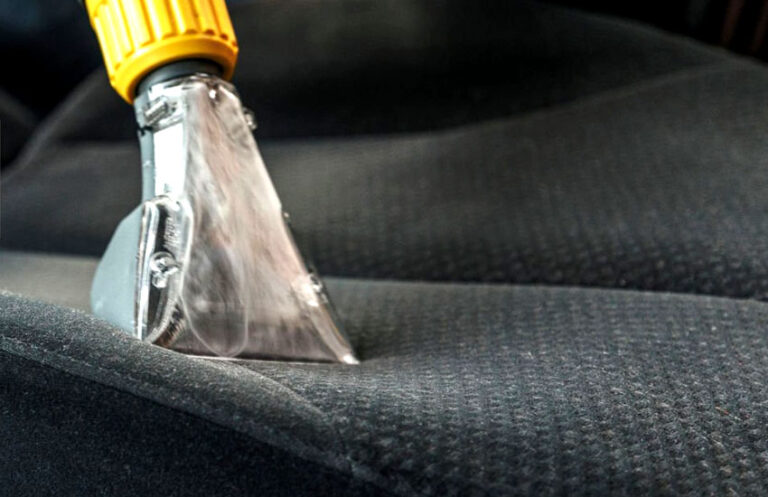As an Amazon Associate, I earn from qualifying purchases at no extra cost to you.
How to Clean Fuel Injectors Without Removing Them: Expert Guide
You want your car to run smooth and strong, but fuel injectors can get dirty and slow things down. Cleaning them without taking them out can save you time and money. I've been there, frustrated with my car’s rough idling and poor fuel economy.
The good news is, you can clean your fuel injectors right in place using simple methods that work. In this article, I'll show you easy and safe ways to clean fuel injectors without removing them, so your engine feels fresh and powerful again.
Check Your Car's Fuel Injector Condition
Before jumping into cleaning, it's important to know how dirty your fuel injectors really are. Sometimes, symptoms like rough idle, poor gas mileage, or engine misfires hint that injectors need attention. You can also use an OBD-II scanner to check for trouble codes related to fuel delivery. This helps confirm if fuel injectors are causing problems.
If you notice your car is hesitating or the engine struggles during acceleration, this usually means fuel injectors might be clogged or dirty. These tiny parts spray fuel into the engine in a fine mist, so any dirt blocks proper fuel flow and hurts performance.
One easy way to check is to listen for any strange engine noises or look at your car's exhaust smoke color. Dark smoke or smells of gasoline can be signs. Also, if your car's check engine light is on, it's a good idea to have it checked.
Checking the fuel injector's condition first helps you decide if cleaning them in place is the right step or if you need a professional. Sometimes a small cleaning solution is enough, and other times more work might be needed.
- Look for symptoms like rough idle, misfires, or poor gas mileage
- Use an OBD-II scanner for error codes
- Listen for strange engine sounds or watch exhaust smoke
- Decide if cleaning is needed before starting
Choose the Right Fuel Injector Cleaner
Using the right cleaner is key to cleaning fuel injectors without removing them. Fuel injector cleaners come in bottles that you pour into your gas tank or attach directly to your fuel system. The best cleaners break down dirt, gum, and varnish that clog injectors.
Look for a cleaner with good reviews and from a trusted brand. Some cleaners are safe for all engines, while others are made for specific types like gasoline or diesel engines. Always read the label carefully to make sure it fits your car.
Pouring a fuel injector cleaner into your gas tank is the easiest way. As you drive, the cleaner flows through the fuel system and cleans injectors without extra tools. This method is great if you want a simple fix. But if your injectors are really dirty, you might want to use a pressurized cleaning kit. These kits connect directly to the fuel rail and push cleaner through under pressure, which cleans injectors better.
Remember, using cheap or wrong cleaners can harm your engine or cause more damage. Always follow the instructions on the product to avoid problems.
- Pick a cleaner designed for your engine type
- Use trusted brands with good reviews
- Pour cleaner into gas tank for easy cleaning
- Consider pressurized kits for deep cleaning
- Follow product instructions carefully
Prepare Your Vehicle for Cleaning
Getting your car ready for cleaning fuel injectors without removing them is very important. First, make sure your engine is cool before starting. Working on a hot engine can be dangerous and cause burns.
Next, check your vehicle's manual for any specific instructions or warnings about fuel system work. Some cars may need extra steps or safety precautions.
Before adding fuel injector cleaner, fill your gas tank nearly full. This helps the cleaner mix well with fuel and reach the injectors properly. If you use a pressurized cleaning kit, you may need to turn off the fuel pump or release fuel pressure safely. This step is necessary to avoid spills or accidents.
Also, keep a fire extinguisher nearby and work in a well-ventilated area. Fuel vapors are flammable and can be harmful if breathed in too much. Always wear gloves and safety glasses when handling fuel or cleaning chemicals.
Finally, gather all the tools and materials you will need, like the fuel injector cleaner, funnel, rags, and any kit instructions. Having everything ready before you start makes the process smoother and safer.
- Make sure engine is cool before starting
- Check your car manual for fuel system info
- Fill gas tank almost full before adding cleaner
- Handle fuel pressure safely if using pressurized kits
- Work in a ventilated space with safety gear
- Prepare all tools and materials ahead
Add Fuel Injector Cleaner Through the Gas Tank
One of the easiest ways to clean your fuel injectors without removing them is by using a fuel injector cleaner that you pour directly into your gas tank. This method does not need special tools and can be done at home in a few minutes.
Start by reading the instructions on the cleaner bottle. Most bottles say how much to add depending on your gas tank size. Use a funnel to pour the cleaner into your fuel tank slowly. This helps prevent spills and waste.
After adding the cleaner, drive your car normally. The cleaner mixes with fuel and flows through the fuel injectors as the engine runs. It helps dissolve dirt and buildup inside the injectors, making fuel spray better and your engine run smoother.
It's best to drive for at least 30 to 50 miles after adding the cleaner. This gives the solution time to work through the whole fuel system. You may notice your car runs better, idles smoother, or has better power.
You can repeat this process every few thousand miles as preventive care. Regular use of fuel injector cleaner keeps injectors from getting clogged again and helps maintain good engine performance.
- Use the cleaner bottle instructions to measure properly
- Pour cleaner slowly into the gas tank with a funnel
- Drive at least 30 to 50 miles to let cleaner work
- Notice improvements in engine smoothness and power
- Repeat every few thousand miles for maintenance
Use a Fuel Injector Cleaning Kit for Better Results
If your fuel injectors are very dirty, using a cleaning kit can be more effective than just adding cleaner to the gas tank. These kits come with a container for cleaner and special hoses that connect directly to the fuel system.
To start, you need to relieve the fuel pressure safely by following your vehicle's instructions or a guide. This prevents fuel spills when disconnecting fuel lines.
Next, connect the cleaning kit to the fuel rail or fuel line as directed. The kit pushes cleaner through the injectors under pressure, which removes stubborn deposits better than tank cleaners alone.
Run the engine with the cleaning kit attached. The cleaner circulates through the injectors, dissolving dirt and buildup quickly. This process usually takes 15 to 30 minutes.
After cleaning, disconnect the kit and reconnect the fuel system properly. Check for leaks or problems before driving the car again.
Using a cleaning kit takes more time and care, but it cleans injectors deeply and is great for older or heavily clogged systems.
- Safely relieve fuel pressure before starting
- Connect cleaning kit to fuel rail or line
- Run engine to push cleaner through injectors
- Clean for 15 to 30 minutes under pressure
- Check fuel system for leaks after cleaning
Maintain Your Fuel Injectors Regularly
Cleaning fuel injectors once is helpful, but keeping them clean regularly is best for your car's health. Dirty injectors make your engine work harder and waste fuel.
A good way to maintain injectors is by adding fuel injector cleaner to your tank every few thousand miles. This stops buildup before it becomes a problem.
Also, use good quality fuel from trusted gas stations. Low-quality fuel can cause deposits and damage injectors over time.
Keep up with regular car maintenance like changing air filters and spark plugs. These help your engine breathe well and burn fuel efficiently, which protects injectors.
If you notice signs like rough idle or poor fuel economy again, don't wait. Clean the injectors right away or get a professional check.
By making these small habits part of your routine, your injectors stay clean, and your car stays smooth and powerful longer.
- Use fuel injector cleaner regularly every few thousand miles
- Choose good quality fuel to avoid deposits
- Change air filters and spark plugs on time
- Watch for injector problems and act quickly
- Keep fuel injectors clean for better engine health
Final Thoughts
Cleaning your fuel injectors without removing them is a smart and easy way to keep your car running well. By checking the injector condition, choosing the right cleaner, and using simple methods like adding cleaner to your tank or using a cleaning kit, you can save money and avoid complicated repairs. Regular maintenance helps prevent future problems and keeps your engine smooth and fuel-efficient. With some care and attention, your car will feel fresh and strong for many miles.
Frequently Asked Questions (FAQs)
Is it safe to clean fuel injectors without removing them?
Yes, it is safe to clean fuel injectors without removing them if you use the right products and follow instructions carefully. Many fuel injector cleaners are designed to work through the gas tank or with pressurized kits, so there is no need to take the injectors out. However, safety precautions like working in a ventilated area, wearing gloves, and making sure the engine is cool are important. If you're unsure or your car has serious problems, consulting a mechanic is always best.
Can fuel injector cleaner damage my engine?
If you use fuel injector cleaner correctly and choose a good quality product, it should not damage your engine. Problems happen mostly when using cheap or wrong cleaners or adding too much cleaner at once. Always follow the instructions on the cleaner bottle or kit carefully. Using cleaner regularly in small amounts is safer and helps keep injectors clean without harming the engine.
Do I need special tools to clean fuel injectors without removing them?
No, you don't always need special tools. The easiest way is to pour fuel injector cleaner into your gas tank, which requires just a funnel. For deeper cleaning, pressurized cleaning kits are available, but they require some basic tools and knowledge to connect safely. If you want a simple solution, adding cleaner to the fuel tank is enough for many drivers.
Is it necessary to drive after adding fuel injector cleaner?
Yes, driving after adding fuel injector cleaner is important. The cleaner mixes with fuel and flows through the injectors while the engine runs. Driving for about 30 to 50 miles allows the cleaner to work fully and remove dirt inside the injectors. Without driving, the cleaner won't reach the injectors well and won't clean them properly.
Can cleaning fuel injectors improve fuel economy?
Yes, cleaning fuel injectors can improve fuel economy. Dirty or clogged injectors spray fuel unevenly, causing the engine to burn more fuel than needed. When injectors are clean, fuel sprays evenly and burns better, which helps the engine run more efficiently and saves gas. Many drivers notice better mileage after cleaning fuel injectors.
Do I have to clean fuel injectors regularly?
While it's not necessary to clean fuel injectors very often, regular cleaning every few thousand miles helps prevent buildup and keeps your engine healthy. If you use good quality fuel and maintain your car well, cleaning can be less frequent. But for older cars or those using lower-quality fuel, more frequent cleaning might be needed.
Is there a way to know if cleaning worked?
You can tell cleaning worked if your engine runs smoother, idles better, and accelerates without hesitation. You may also see better gas mileage and fewer engine problems like misfires. If symptoms continue, it might mean your injectors need more cleaning or professional help.
Can I clean fuel injectors myself safely?
Yes, many people clean their fuel injectors themselves safely using the methods described here. Pouring cleaner into the gas tank is simple and safe with basic precautions. Using a cleaning kit takes more care and understanding but is still doable for many DIYers. Always follow safety steps and product instructions. If unsure, asking a mechanic for help is a good idea.




